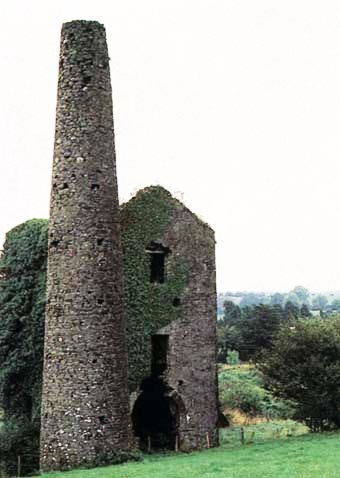
Mardyke Engine House
Used with kind permission of
Slieveardagh Rural Development Ltd
An outlier of Westphalian rocks, on the border of counties Kilkenny and Tipperary, which are folded into a series of near parallel synclines. In consequence of this, of the nine seams present, only the lowest two, the Glengoole No.1 and No.2, are present throughout. Except for in the cores of synclines, the other seams have been mostly eroded. All the coal is anthracite, and the Glengoole No.2 seam was of excellent quality, with low sulphur (0.8%), low ash levels (4.0%) and high calorific value. It was typically 18 inches thick, but was prone to localised thickening and thinning, as well as crushing of the coal, caused by thrusting. The latter resulted in a high proportion of coal fines (duff or culm) in some of the mined coal. At Ballynunty, the duff content was typically 80 – 100%
Mining dates from at least the mid-seventeenth century, but may be earlier. Until the nineteenth century it was small-scale, often land owners serving their own needs. In 1826, however, the Mining Company of Ireland opened collieries at Mardyke, and used a steam engine for pumping. As well as an engine house, the company built at least 25 houses for its workers, offices, a police barracks and a school.
Mardyke closed in 1833 because of the high proportion of duff, but undeterred the company had mines at Foilacamin and The Commons. The company also leased Earlshill, where a chimney, magazine and the manager’s house survive, and Ballyphilip collieries in 1844 and kept going until around 1890.
Mining had died out by 1920, but in 1941 Mianraí Teoranta, a state mining company, reopened Ballynunty and Lickfinn collieries. They both proved uneconomic, however, and so operations were moved to the Copper basin in September 1948. At first called Copper, this colliery was soon renamed Clashduff. In January 1949 it became Ballingarry and worked until 1957.
Gorteen worked from 1957 to 1972, and its large spoil heap remains. The last mining in the area was the sinking of a drift mine at Lickfinn in 1978. It worked until 1990.
An engine house and chimney at Mardyke are probably survivals from the 1859-1865 reworking. A ventilation chimney still stands in fields near Ballingarry colliery, and there are an engine house and chimney at Coalbrook.
Further information:
- Irish maps viewer
- Slieve Ardagh District Report
- Slieveardagh Rural Development
- Coal mining in Slieveardagh
- NMRS online mapping of the collieries of the British Isles

